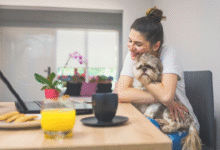
Pet-Proofing Your Home Tips to Keep Your Furry Friends Safe
Pet-proofing your home keeps pets safe from hazards Learn essential tips to protect your furry friends from household dangers in our guide.
Pet-proofing your home is one of the most important steps you can take as a responsible pet owner. Our homes are filled with everyday items that can pose serious risks to curious cats and dogs from electrical cords and toxic plants to small objects that can be choking hazards. Just as you would childproof a house for a toddler, creating a safe environment for your pets helps prevent accidents, injuries, and costly emergency vet visits. By identifying and eliminating potential dangers, you can ensure your furry companions explore and play without unnecessary risks.
Whether you have a mischievous kitten, an energetic puppy, or a senior pet with changing needs, pet-proofing your home requires careful attention to every room. Many common household items, including certain foods, cleaning supplies, and loose wires, can be life-threatening if ingested or chewed. Taking proactive measures not only safeguards your pet’s health but also gives you peace of mind knowing your home is a secure and welcoming space for your four-legged family members. This guide will walk you through essential pet-proofing strategies to keep your beloved animals safe and happy.
Pet-Proofing Your Home Tips to Keep Your Furry Friends Safe
Preventing Accidents and Injuries
Pets explore their surroundings with their mouths and paws, often unaware of hidden dangers. Chewing electrical cords can lead to burns or electrocution, while small objects pose choking hazards. Pet-proofing minimizes these risks by securing loose Pet-Proofing, removing choking hazards, and blocking access to dangerous areas like balconies or pools. A properly pet-proofed home allows your furry friends to roam safely without constant supervision.
Avoiding Poisoning and Toxic Exposure
Many common household items from certain foods (like chocolate and grapes) to cleaning supplies and houseplants can be toxic to pets. Curious animals may ingest these substances, leading to severe illness or even death. Pet-proofing involves storing chemicals securely, choosing pet-safe plants, and keeping human food out of reach. By eliminating these hazards, you create a healthier living space where pets can thrive without accidental poisoning risks.
Room-by-Room Pet-Proofing Strategies
The Kitchen A Hub of Hidden Dangers
The kitchen is one of the most hazardous areas for pets due to toxic foods, sharp objects, and accessible trash bins. Chocolate, grapes, onions, and xylitol (found in sugar-free gum) are just a few common foods that can be deadly to pets. Store all food securely in cabinets or pet-proof containers and avoid leaving dishes unattended on countertops. Additionally, pets can easily burn themselves on hot stoves or ingest harmful cleaning chemicals. Consider using childproof latches on lower cabinets and keeping trash cans behind closed doors or with secure lids. Small appliances like blenders and toasters should be unplugged when not in use to prevent pets from chewing on cords.
The Living Room Minimizing Choking and Electrical Hazards
Living rooms often contain loose wires, small decor items, and toxic plants all of which can be dangerous to pets. Electrical cords should be tucked away or covered with protective tubing to prevent chewing. Houseplants like lilies, poinsettias, and aloe vera can be poisonous to pets, so opt for pet-safe alternatives such as spider plants or Boston Pet-Proofing. Keep small objects like remote controls, coins, and children’s toys out of reach, as they can become choking hazards. If you have a fireplace, use a safety gate to prevent burns, and ensure that heavy furniture is stable to avoid tipping accidents.
The Bathroom Securing Medications and Cleaning Supplies
Many pets are drawn to the bathroom due to the presence of water and intriguing smells. However, this room often contains medications, cleaning agents, and personal care products that can be toxic. Always store medications in high cabinets and never leave pill bottles on countertops where pets can knock them over. Toilet bowl cleaners and bleach can cause severe poisoning, so keep these products in locked cabinets. Additionally, close the toilet lid to prevent pets from drinking contaminated water or accidentally falling in.
The Bedroom Eliminating Small Object Risks
Bedrooms may seem harmless, but they often contain small items like jewelry, hair ties, and socks that pets can swallow. Cats, in Pet-Proofing, are attracted to strings and ribbons, which can cause intestinal blockages if ingested. Keep laundry baskets covered and store accessories in drawers. If you use essential oil diffusers, ensure they are pet-safe, as some oils (like tea tree and eucalyptus) can be toxic to animals. Also, check under beds and dressers for hidden hazards like loose screws or dropped pills.
The Garage and Outdoor Areas Preventing Poisoning and Escapes
Garages often store antifreeze, pesticides, and sharp tools all of which can be deadly to pets. Antifreeze has a sweet taste that attracts animals but is highly toxic, always clean spills immediately and store chemicals in sealed containers. In the yard, check for gaps in fences where pets could escape, and remove toxic plants like azaleas and oleander. Pools and ponds should be covered or fenced off to prevent drowning, and outdoor trash bins must have secure lids to stop pets from scavenging harmful waste.
Additional Pet-Safety Measures
To create a truly pet-safe environment, several key precautions should be implemented. Pet gates serve as effective barriers to keep curious animals away from dangerous zones like staircases or rooms with hazards. Chew-proof furniture and durable cord protectors help prevent destructive chewing behaviors that could lead to choking or electrocution Pet-Proofing. Every pet owner should keep emergency vet contacts prominently displayed, as quick access to professional help can be lifesaving in critical situations. Positive reinforcement training teaches pets to steer clear of off-limit areas without fear-based methods.
Read More: DIY Grooming Tips for Healthy Pets in Wisconsin
Conclusion
Pet-proofing your home is an essential responsibility that comes with the joy of pet ownership. By taking the time to identify and eliminate potential hazards, you create a safe haven where your furry companions can thrive without unnecessary risks. From securing toxic substances to protecting electrical cords, each precaution you implement contributes to your pet’s wellbeing and gives you priceless peace of mind. Remember, a pet-proofed home isn’t just about preventing emergencies it’s about creating an environment where your pets can explore, play, and relax safely every day.
As you continue pet-proofing your home, stay vigilant and adapt your approach as your pets grow and their behaviors change. What protects a curious puppy may differ from what keeps an aging cat safe. Regularly reassess your living space, introduce new safety measures as needed, and always keep emergency vet contacts handy. Your efforts to maintain a pet-friendly home will be rewarded with years of happy, healthy companionship, ensuring your beloved animals enjoy the same comfort and security they bring to your life.
FAQs
Why is pet-proofing important?
Pet-proofing prevents accidents, poisoning, and injuries by removing hazards like toxic foods, choking hazards, and dangerous chemicals from your pet’s reach.
What common foods are toxic to pets?
Chocolate, grapes, onions, garlic, xylitol, and alcohol are highly toxic and should never be accessible to pets.
How can I protect my pet from electrical cords?
Use cord covers, hide wires behind furniture, or apply bitter-tasting sprays to deter chewing.
Are all houseplants safe for pets?
No plants like lilies, aloe vera, and pathos are toxic. opt for pet-safe alternatives like spider plants or bamboo.
How often should I reassess my home for pet hazards?
Regularly check for new risks, especially when introducing new furniture, plants, or household products.







